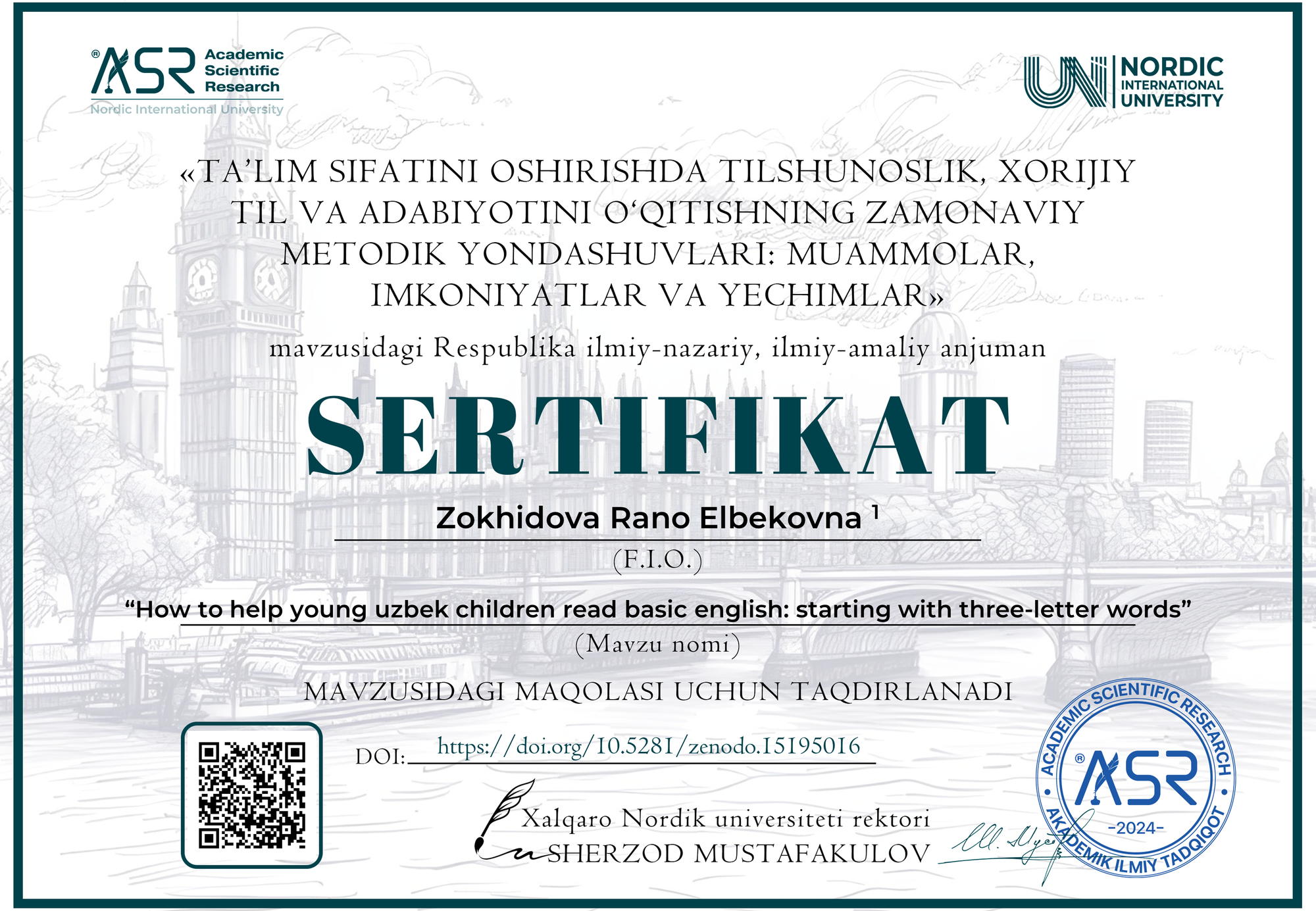Zokhidova Rano Elbekovna 1

DOI: https://doi.org/10.5281/zenodo.15195016
Zenodo community: https://zenodo.org/records/15195016
Nordic_press journal: https://research.nordicuniversity.org/index.php/nordic/article/view/2331
MAQOLANI YUKLAB OLISH
SERTIFIKATNI YUKLAB OLISH
REVIEW:
Zokhidova Rano Elbekovna's article provides valuable insights into effective teaching methods aimed at helping young Uzbek children learn to read basic English. Focused primarily on introducing three-letter words, the article explores practical techniques that address the challenges faced by young learners, especially those for whom Uzbek is the first language. The strategies presented in the paper are designed to facilitate the acquisition of reading skills, while also emphasizing phonetics, self-confidence building, and engaging learning activities.
Summary and Key Insights
The article begins with a discussion of the challenges that young children face when learning English, particularly when it comes to understanding the relationship between letter names and their corresponding sounds. As the English alphabet differs significantly in terms of pronunciation from the Uzbek alphabet (despite similarities in their written forms), the author notes that teaching phonetics becomes crucial.
The article outlines a multi-faceted approach to teaching reading, emphasizing both the names and sounds of letters. Through this method, students can begin to distinguish between the sound of the letter and the word it forms. For example, teaching the letter 'A' and its pronunciation as [æ], followed by an example like "apple," provides learners with a concrete understanding of the letter's sound.
The key method proposed for early learners is teaching three-letter words, which are relatively simple and manageable for young children. These words are introduced with visual aids, such as flashcards with pictures and letters, which reinforce the association between letters and their sounds. In addition, the use of dots under each letter helps to guide the children in understanding the number of sounds in a word, helping to avoid common mispronunciations.
The article also introduces practical teaching techniques such as "look and say" and "object pointing," where teachers use familiar objects like toy cars to engage students in reading aloud. This approach connects real-world objects with the words they represent, facilitating a deeper understanding and retention of vocabulary.
Strengths of the Article
One of the most notable strengths of this article is its clear, structured approach to teaching young children how to read. Zokhidova emphasizes phonetics and incorporates effective visual aids and activities to facilitate learning. The inclusion of activities like finger tracing and "Game-Based Learning" (GBL) is particularly beneficial, as these techniques actively involve children in the learning process. These strategies are well-supported by research, with references to established experts such as Peck et al. (1993) and Fajarina (2017), adding academic credibility to the proposed methods.
The article also takes into account the psychological aspects of learning to read, notably the importance of building confidence in children. The author stresses the importance of encouragement, positive reinforcement, and creating a welcoming classroom atmosphere. By fostering a supportive environment, teachers can motivate shy or hesitant learners to participate and take risks, which is essential for their development.
Additionally, the use of games such as flashcard matching, three-letter word bingo, and word fishing adds a fun and interactive element to the learning process. These activities not only make learning enjoyable but also promote collaboration among students, which can enhance their overall engagement.
Areas for Improvement
While the article offers a solid foundation for teaching English reading to young learners, it could benefit from a deeper exploration of the challenges that arise during the implementation of these methods. For instance, the author mentions the importance of a teacher's intonation and positive reinforcement but does not elaborate on how to manage a diverse classroom where some students might struggle more than others. Providing specific examples of how to address varying levels of proficiency could add more depth to the teaching strategies.
Moreover, while the games and activities discussed are highly beneficial, the article could include more detailed instructions or variations of these games to accommodate different learning styles or classroom environments. Offering more practical advice on how to tailor these methods to a range of student needs would make the article even more useful for teachers with varying levels of experience.
Conclusion
Overall, Zokhidova Rano Elbekovna's article provides a thoughtful and practical guide to teaching young Uzbek children how to read basic English. By focusing on phonetics, interactive activities, and building self-confidence, the article offers a well-rounded approach to early literacy development. The combination of visual aids, games, and positive reinforcement creates an engaging learning environment that promotes both cognitive and emotional growth. This resource is a valuable read for teachers of young learners, particularly those working in bilingual or multilingual classrooms, and offers useful strategies for overcoming common challenges in early reading instruction.



